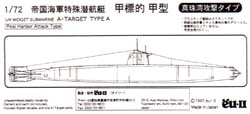
 The sturdy cardboard box features a very nice line drawing of the boat. Inside were two sprues of kit parts. One had the hull split in the middle sides. The other contained the conning tower, aft fins and rudders and the various kit parts. The parts are molded in hard black styrene and feature engraved panel lines and excellent fine detail. There is little to no flash. The hull detail is very tastefully done. Kit instructions are in Japanese but feature seven excellent assembly drawings that leave nothing to the imagination. The last page of the instructions includes drawings of two possible configurations and markings. Painting suggestions were in English and Japanese. Anti-fouling rigging was represented.
The sturdy cardboard box features a very nice line drawing of the boat. Inside were two sprues of kit parts. One had the hull split in the middle sides. The other contained the conning tower, aft fins and rudders and the various kit parts. The parts are molded in hard black styrene and feature engraved panel lines and excellent fine detail. There is little to no flash. The hull detail is very tastefully done. Kit instructions are in Japanese but feature seven excellent assembly drawings that leave nothing to the imagination. The last page of the instructions includes drawings of two possible configurations and markings. Painting suggestions were in English and Japanese. Anti-fouling rigging was represented.